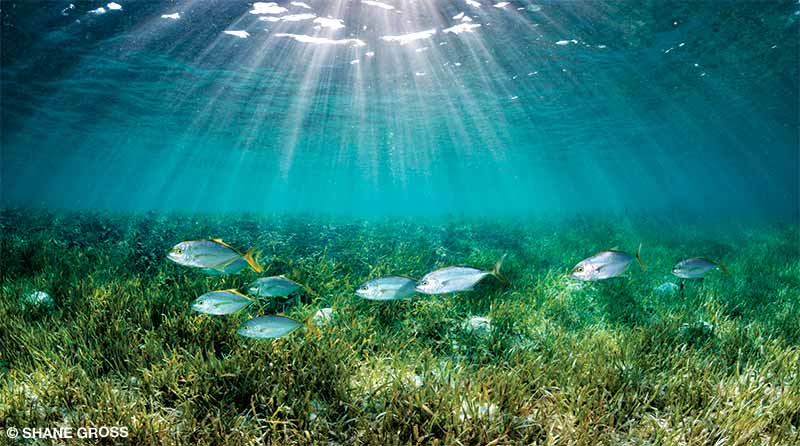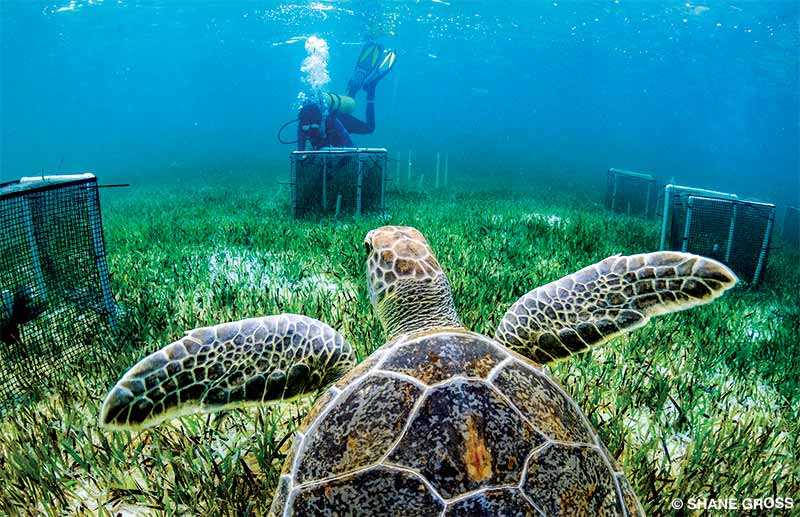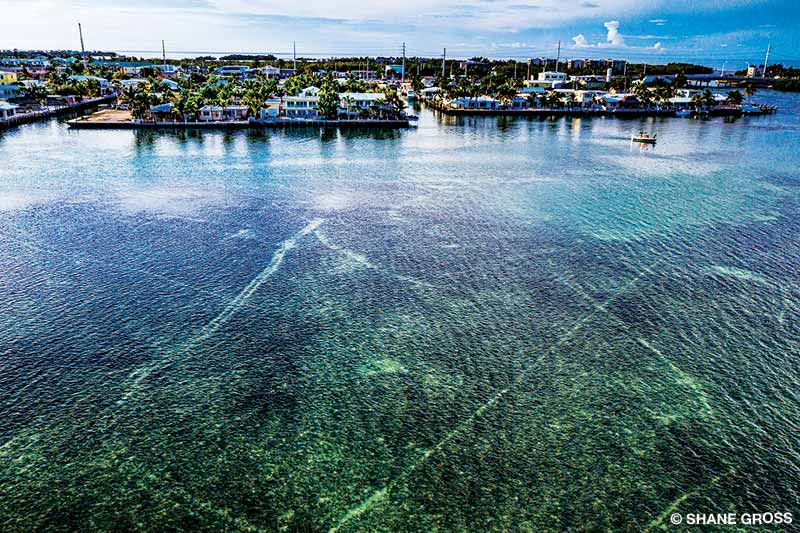Por qué proteger esta planta marina que está desapareciendo es fundamental en nuestra lucha por salvar el clima y la biodiversidad.
Levanté la roca y mi llave había desaparecido. Era un mediodía de julio y el calor de los Cayos de la Florida era agobiante. Estaba empapado y tenía algas marinas en el cabello. Mi teléfono, billetera, agua potable, llave del hotel, gafas de sol y todo lo demás, con excepción de mi traje de baño mojado y mi cámara submarina, estaban en el caluroso automóvil de alquiler, que estaba cerrado. Sabía que había puesto el llavero allí, y había estado observando el área desde el agua. Nadie podría haberla tomado y me preguntaba, incrédulo, dónde demonios podría estar.
Había estado sentado en una pradera de pastos marinos, con la esperanza de que un tímido tiburón cabeza de pala nadara en frente de mi lente. Estos tiburones martillo pequeños fueron clasificados en 2018 como los primeros tiburones omnívoros conocidos del mundo. Una pregunta central a la que se enfrentaban los científicos era qué cantidad del contenido de nutrientes de los pastos marinos estaban tomando los tiburones.
En un estudio dirigido por Samantha Leigh, Ph.D., de la Universidad Estatal de California, Dominguez Hills (California State University, Dominguez Hills), investigadores les dieron a tiburones cabeza de pala cautivos una dieta con un 90 por ciento de pastos marinos por tres semanas. Un análisis de la digestión de los tiburones mostró que podían obtener nutrientes de los pastos marinos y manifestaban un crecimiento con una dieta principalmente vegetariana. Debido a que otros omnívoros marinos habían tenido efectos positivos sobre las cadenas alimentarias, los investigadores plantearon que la ingesta de nutrientes de los tiburones implicaba que “deberíamos reevaluar las funciones de los tiburones cabeza de pala en la ecología de los pastos marinos porque podrían ser responsables de un pastoreo significativo y el transporte de nutrientes dentro de los frágiles ecosistemas de pastos marinos”.1

Los tiburones consumidores de plantas son solo un ejemplo de cómo la ciencia cambia nuestro parecer de los pastos marinos y pone de manifiesto su importancia.
Los pastos marinos son diferentes a las algas marinas; son más similares a las plantas florales que crecen en tierra. Hay aproximadamente 72 especies en aguas costeras en todos los continentes, excepto la Antártida, desde el ecuador hasta las áreas frías Zostera marina crece en el Ártico y puede sobrevivir bajo el hielo.
Unas semanas antes de perder la llave en el calor de Florida, estaba usando un traje seco, pero aun así temblando en agua con una temperatura de 1 °C (35 °F) en Terranova, Canadá. Me había unido a un pequeño equipo de científicos de Pesquerías y Océanos de Canadá (Fisheries and Oceans Canada, DFO), que han estado monitoreando las poblaciones de peces y zostera marina durante décadas.
A principios de la década de 1990, una de las pesquerías más grandes del mundo colapsó. Una moratoria de 1992 sobre la pesca de bacalao se cobró más de 30.000 puestos de trabajo en Terranova. La población de bacalao del Atlántico había sido mal gestionada y fue objeto de una grave sobrepesca. En los casi 30 años que han transcurrido desde entonces, la población no ha vuelto a alcanzar niveles donde la pesca comercial pueda desarrollarse como alguna vez lo hizo. Tener abundantes hábitats de pastos marinos donde los jóvenes puedan esconderse y alimentarse es fundamental para aumentar las cantidades de bacalao.

Muchas de las principales especies para la pesca del mundo dependen de los pastos marinos en algún momento de su ciclo de vida. Aproximadamente el 70 por ciento de las especies pesqueras de Florida, por ejemplo, pasan un tiempo en los pastos marinos.2
Al igual que los tiburones cabeza de pala, los bacalaos del Atlántico son tímidos cuando hay personas. Preparé mi equipo fotográfico submarino en un trípode en frente de una exuberante área de pastos marinos y me alejé, y con la mano congelada agarré el disparador remoto.
Un diminuto bacalao del Atlántico revoloteaba ocasionalmente frente a mi lente y yo tomaba una fotografía. Entre buceos y sorbos de chocolate caliente, bromeaba con el equipo sobre mi próximo viaje a la soleada España después de eso, a la vez que intentaba lograr que entraran en calor y sintieran celos.
Cerca de la costa española del mar Mediterráneo, nadé entre una de las especies de pastos marinos más antiguos y grandes del planeta Posidonia oceánicaEl sistema de raíces de la planta está conectado debajo del lecho marino y se extiende por más de 14 km (9 millas). Los científicos estiman que este organismo podría tener hasta 200.000 años. La especie ha tenido una lenta recuperación tras la pérdida y ha disminuido debido al cambio climático y otras actividades humanas. Los investigadores están reuniendo datos sobre su pérdida y las áreas donde no está disminuyendo, con la esperanza de que una mejor comprensión ayude a revertir la tendencia.

Los pastos marinos están disminuyendo en todo el mundo. Algunas estimaciones sugieren una pérdida total de hasta un 7 por ciento al año durante la década de 1990 y principios de la década de 2000.3 Factores como polución, desarrollo costero, menor claridad del agua, algunas actividades de pesca, acciones de amarre y prácticas de navegación, y, desde luego, el cambio climático, se encuentran entre aquellos que contribuyen a la disminución.
En mayo de 2019, me uní a un equipo de voluntarios e investigadores del Instituto de Ciencias Marinas de Virginia (Virginia Institute of Marine Science, VIMS) para continuar con un proyecto de restauración de pastos marinos de 20 años mediante una técnica desarrollada por el profesor de VIMS Robert “JJ” Orth, Ph.D. Su sistema de siembra es increíblemente eficaz y ha restablecido más de 9.000 acres de zostera saludable que ha mostrado signos de desarrollo para convertirse en un ecosistema completo. Este método puede ser prometedor para un rebrote en otros lugares, pero proteger lo que aún tenemos debería ser la prioridad.
Los beneficios de proteger los pastos marinos no deben subestimarse. Los pastos marinos purifican el agua, ayudan a proteger contra la erosión costera, ayudan a mantener las pesquerías de pequeña escala que sustentan comunidades y aumentan las poblaciones de peces y la biodiversidad. Absorben mucho más carbono por área que los bosques terrestres y reducen la acidificación del océano. Tener pastos marinos saludables se traduce en un océano más próspero.

Con todas estas ventajas, ¿por qué los turistas no están acudiendo en manada para explorar las praderas de pastos marinos? He tenido encuentros con cocodrilos y tiburones con dientes afilados, adorables dugongos y tortugas, increíbles caballitos de mar y pulpos, extraños peces grumo y cangrejos herradura y muchas otras criaturas entre los pastos marinos.
En Florida, un solo tiburón cabeza de pala eventualmente nadó frente a mi cámara, echó una rápida mirada y desapareció. Tenía una sola fotografía que podía usar después de nueve días de esperar pacientemente. Nunca encontré mi llave. Un cangrejo probablemente la arrastro por uno de los muchos hoyos cercanos —quizás fue una pequeña venganza de la naturaleza. Si nos permitimos destruir gran parte de la naturaleza, me preocupa su represalia contra todos nosotros. Hagamos lo que podamos para proteger nuestros pastos marinos —esa es una llave que no queremos perder.
Notas
1. Leigh SC, Papastamatiou YP, German DP. Seagrass digestion by a notorious ‘carnivore.’ Proceedings of the Royal Society B. 2018; 285(1886). doi.org/10.1098/rspb.2018.1583. royalsocietypublishing.org/doi/full/10.1098/rspb.2018.1583
2. Importancia de las praderas marinas. Comisión de Conservación de la Pesca y la Vida Silvestre de Florida. myfwc.com/research/habitat/seagrasses/information/importance
3. Salinas C, Duarte CM, Lavery PS, et al. Seagrass losses since mid-20th century fueled CO2 de las reservas de carbono del suelo. Biología del cambio global 2020; 26(9):4772–4784. doi.org/10.1111/gcb.15204. onlinelibrary.wiley.com/doi/full/10.1111/gcb.15204
Explore más
Vea este vídeo para saber más sobre el papel de las praderas marinas en el cambio climático.
© Alert Diver - Q3/Q4 2021